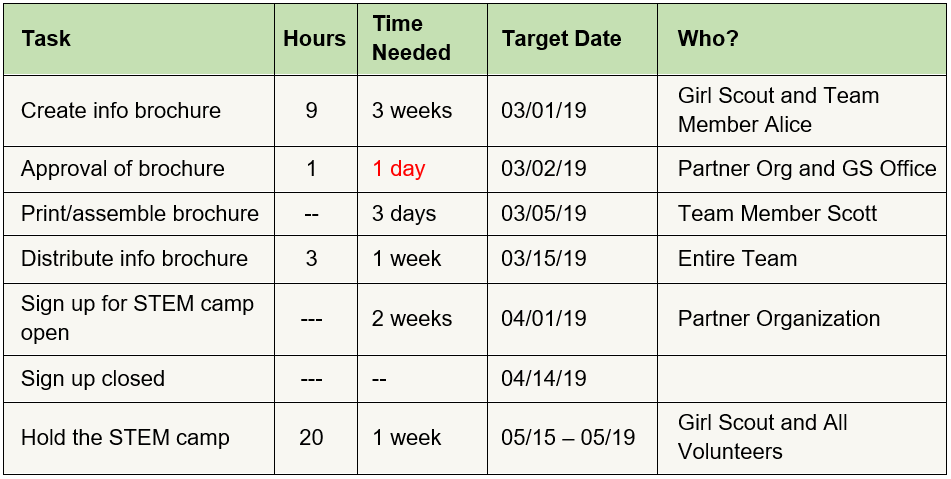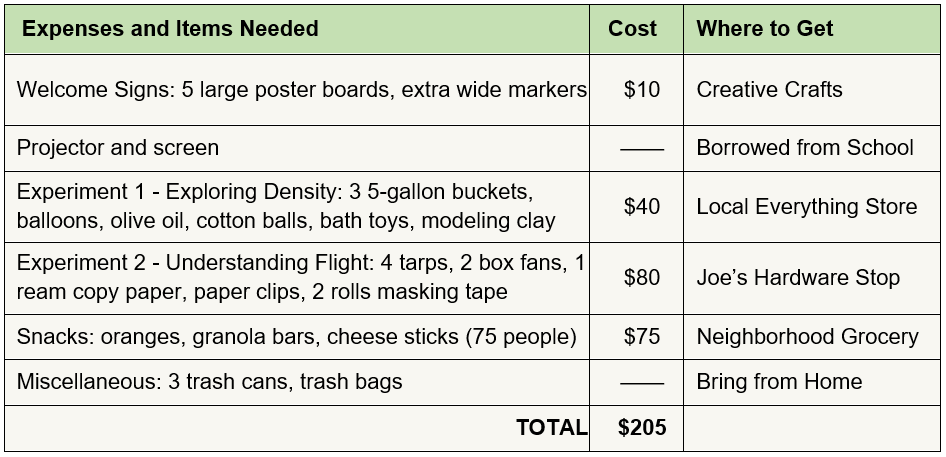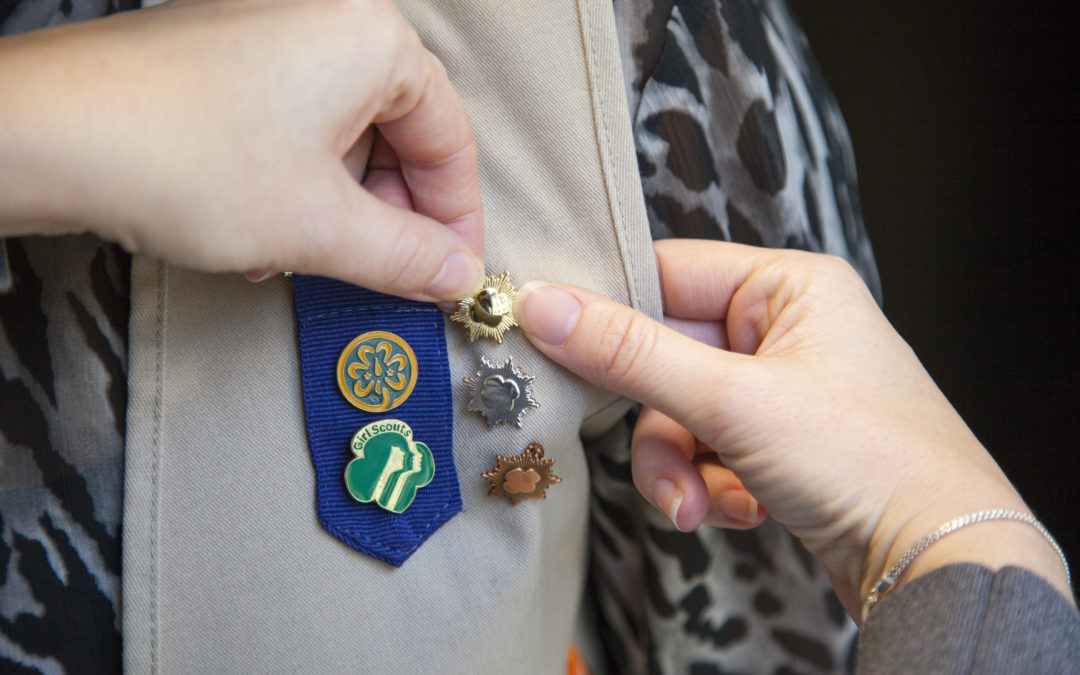So your Girl Scout has chosen the topic for her Girl Scout Gold Award, identified a root cause, and identified a problem to solve. Now, it’s time for her to plan her project, and that means developing a timeline and budget.
She will consider, among other things, what should be done, what the key steps are, who will be responsible for each step, and who needs to approve the project. Girls are strongly encouraged to take notes during the project planning and keep those notes. One of those ideas might be needed later on! Although they require a lot of details, the Timeline and Budget forms that accompany a Gold Award project proposal are key tools designed to ensure a girl’s success with her Gold Award project.
Save it for later!
Developing an action plan, one step at a time.
Developing a project timeline serves three critical purposes:
- The timeline helps the girl think through the major elements of her project, the sequence of events, whether she has enough hours planned, and key milestone dates and dependencies (which task must be completed before another task can start). The minimum time requirement for a Girl Scout Gold Award is 80 hours. Girls may count up to 8 hours of their research and planning effort (including writing the proposal).
- The timeline provides the Gold Award Committee a clear outline of the project plan so they can assess that plan for important tasks that may have been overlooked (missing from the timeline) and tasks that may not have been allotted sufficient time, so they can help her avoid pitfalls and mistakes.
- The timeline needs to show the balance between “working tasks” vs. “leadership tasks”. Working tasks are tasks those related to creating and building the content of the project. Leadership tasks are associated with coordinating and directing the work of the team. This includes delegating, planning meetings, training volunteers, resolving conflicts, setting priorities, etc… Time spent in a leadership role should account for a minimum of 20% of the total project hours.
Simple projects may have a dozen or so items listed on the timeline, while complex or large-scale projects could have twenty-five or more items on the timeline. Girls will use this same timeline to track the progress of their project against their planned target dates, and log the actual time spent on those tasks.
Project Timeline – Planning Forward or Backward?
There are two ways to approach building a project timeline—planning forward, and planning backwards:
- Planning forward: Girls can use this approach when they know when they want to start their project, but the end time is not particularly important. That is, the project is not dependent on other events such as the start/end of the school year, summer camp dates, or sports seasons.
- Planning backward: Girls can use this approach when their project needs to align with specific, pre-scheduled events or deadlines such as a district-wide science fair, public community event hosted by another organization, or key date like Fourth of July, or Veteran’s Day.
To develop a project timeline based on planning forward, the girl starts her project timeline on her desired start date, and then builds the project timeline by adding each task or significant milestone in order of completion. Once all the tasks, and their duration or target dates have been added to the overall schedule, the girl can determine the final completion target date for her project.
To develop a project timeline based on planning backward, the girls starts her project timeline with the project deadline, and then adds tasks and significant milestones in reverse order.
- Tasks that need to be done the day before the event…
- Tasks that need to be done the week before the event…
- Tasks that needs to be done two weeks before the event…
- Tasks that need to be done a month before the event…
Pro Tip: Being a senior in high school is a full-time job, so Girl Scouts are encouraged to start their Gold Award project before their senior year! It is a good idea to build some “just in case” time into the project timeline. Projects rarely go completely according to plan, and that’s okay—in fact, it becomes a great learning experience on being flexible and resilient!
Creating a sample schedule and planning for setbacks.
When creating a project schedule, girls should consider:
- What needs to be done?
- How long will it take?
- When does it need to be done by?
- Who will do it?
The more details that are in the plan, the easier it will be to explain the project to anyone who need to know—the Gold Award Committee, project advisor, partner organization, volunteer team members.
Here is a sample of a timeline about creating a brochure for STEM camp. Let’s dive into what’s right about it, and what isn’t working.

There are a couple of red flags in the sample timeline above. First, consider the approval of the brochure. Will the approval be received in one day? Since more than one person needs to approve it, and all those people are working full-time, it’s unlikely they can turn a project around that fast. Consider how long it might take for a busy team member to accomplish the task, then add a little extra time onto that to account for other organization’s meeting schedules, response times, and workload.
Here are some words of wisdom from a recent Gold Award Girl Scout: “It took over four months to get my flyer approved to be sent in the school district e-news, I believe it would have been better if I would have started my Gold Award a year earlier.”
Based on STEM camp example above, there is one day planned for getting the brochure approved. If the approval were to take four months, instead of one day allotted, the date of the camp would need to move.
Estimating project expenses and making a plan to meet them.
All Gold Award projects need a budget. Put simply, a project budget is a list of all the resources needed—location, equipment and tools, consumable supplies, food—to execute her project. A girl might not actually spend any money, but she’ll still need a budget that outlines the resources required to get the job done so that she can plan ahead and meet those needs.
- What will be borrowed?
- What will be donated? What organizations will be approached for donations?
- What will need to be purchased?
- How will the girl raise any needed funds? Will they be troop funds or personal funds from their parents or after school job?
As part of creating a Gold Award project plan, a Girl Scout not only needs to know which resources she needs, she also needs to have a solid plan for how to acquire them. Here is a sample budget for a Gold Award project in which the Girl Scout is putting on a science exploration workshop:


The most important thing about this sample budget is that it balances. The total for all the Expenses and Items Needed equals the total from Money Earning and Donations. Just as a girl wouldn’t want to run out of funds before she finishes her project, her Gold Award project cannot generate a profit either.
Pro Tip: If your Girl Scout plans to participate in any money-earning activities, be sure to review the Money-Earning Projects: Approval Required chapter of GSNorCal’s Volunteer Essentials.
If a girl earns more money than she needs to spend on supplies for her project, she must find a way to use those funds to expand the impact of her project and further the goals of the community organization with whom she partnered with for her project. Although she cannot give the excess funds to that organization (that is considered fundraising on behalf of another organization and would violate GSUSA’s nonprofit status), a girl may use excess project funds to purchase supplies or other needed items and donate those to the organization.
When developing a project budget, it is best to add as many relevant details as possible. Of course, there is no need to go overboard—Girl Scouts do not need to list the detailed price for each item (example: poster boards = $1.19 each). In the sample budget above, notice how the budget is organized—supplies are grouped by purpose. This approach can help the girl identify what drives the major expense for her project, so she can plan or adjust as needed.
Organized budgets also help in the Gold Award Committee’s review of the project proposal. The Committee looks for a budget that suits the size and scope of the project. This is typically an indicator of a well-thought out project plan on the path to success. A project plan that included a budget of $20 to cover “science experiment supplies” for a week-long summer camp serving 50 campers would be flagged by the Committee for some follow-up questions because it seems unreasonably low.
Building a complete and effective timeline and budget is critical to the Gold Award process and application. In addition to helping the Committee understand the project, they create a foundation for success by outlining the steps to be taken, the supplies needed to complete the project, and how those supplies will be sourced.
Before submitting the proposal packet, the girl should have someone unfamiliar with the project review the plan and proposal, including timeline and budget. This can be a troop leader, her guardians or parents, or a trusted volunteer. Independent reviewers more easily spot whether any critical information is missing, can confirm that the plan makes sense, and can determine if the timeline and budget match the proposed project.
Remember, incomplete applications do not get reviewed. Applications that include the proposal, timeline, and budget are considered complete—and are ready to go to the Committee for review and feedback.
What to do next:
- Planning and executing a Gold Award project require some serious project management skills! Consider sharing this age-appropriate project-management training from the Project Management Institute with your girl, or check out their tools and resources.
- Is your girl still hunting for the perfect Gold Award topic? These useful steps can help her narrow it down and choose the Gold Award topic that’s right for her.
- Now she knows all about the timeline and budget—time to write the perfect Gold Award Proposal!

Michele Harms—Michele is a long-time member of the South Bay Gold Award Committee. She is a lifetime Girl Scout, now in her 41st consecutive year. As an adult volunteer, Michele has always worked in Older Girl programs. During college, Michele was a mentor for a Cadette troop in San Luis Obispo. She estimates that she has reviewed over 1,500 Gold Award proposals – navigating 3-4 cycles of changes to the program requirements. Michele earned her Gold and Silver Awards with Girl Scouts of Orange County. Outside of Girl Scouts, Michele is a devoted aunt, avid traveler, and Quality Assurance Engineer.

Allison Wright—Allison is a South Bay Gold Award Committee member. She is in her 28th year as a Girl Scout (13 years as a girl, 15 years as an adult). Allison grew up as a Girl Scout in the San Diego council. While at Iowa State University she was a Junior and Cadette Troop Leader in GS of Greater Iowa; a special interest troop leader, and the chair for the council-wide Gold Award committee for GS of Kansas Heartland. Allison is passionate about Girl Scouts; she has continued to volunteer with the program since earning her Gold Award in 2002. Outside of Girl Scouts, Allison is an Aerospace Engineer working in Nondestructive Inspection of Composite Aircraft.


